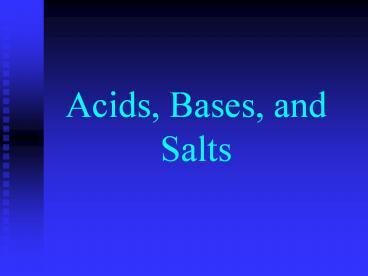Acids, Bases, and Salts - PowerPoint PPT Presentation
Title:
Acids, Bases, and Salts
Description:
Acids, Bases, and Salts I. Properties of Acids Sour taste Change colors of acid-base indicators warm colors turns litmus paper red Some react with active metals to ... – PowerPoint PPT presentation
Number of Views:618
Avg rating:3.0/5.0
Title: Acids, Bases, and Salts
1
Acids, Bases, and Salts
2
I. Properties of Acids
- Sour taste
- Change colors of acid-base indicators warm
colors turns litmus paper red - Some react with active metals to release H2
- Acid Base ? Salt water
- Conduct electric current
3
III. Properties of Bases
- Bitter taste
- Change colors of acid-base indicators cool
colors turns litmus paper blue - Feel slippery
- React with acids to produce salts and water
- Conduct electric current
4
Write dissociation equation balance
- HCl ?
- HNO3 ?
- NaOH ?
- Mg(OH)2 ?
- NaCl ?
- Note any similarities between the equations
5
IV. ARRHENIUS THEORY
- Acids, bases, and salts conduct a current when
dissolved in water - electrolytes - An acid produces H in a water solution
HCl(g) --gt H(aq) Cl-(aq) - A base produces OH- in a water solution NaOH(cr)
--gt Na(aq) OH-(aq)
6
II. Naming Acids - Binary
- Binary acid contains 2 elements hydrogen and
one of the more electronegative elements. - Ex. HF
- 1. Begins with prefix hydro
- 2. Followed by root of name of second element
- 3. Ends with suffix -ic
- hydro fluor ic acid
- H2S
7
II. Naming Acids - oxyacids
- Compound of hydrogen, oxygen, and a 3rd element
that is usually a nonmetal - Formula is usually one or more H atoms followed
by polyatomic anion - Pg. 250
- HNO2 nitrous acid NO2- nitrite
- HNO3 nitric acid NO3- nitrate
- Common industrial sulfuric, nitric, phosphoric,
hydrochloric, acetic
8
Practice problems
- Pg.250 s 18-22
- Pg. 596 1a,1b
9
Strong vs. weak
- Strong acids and bases fully dissociate
- Weak acids and bases partially dissociate
10
V. BRONSTED-LOWRY THEORY
- Acid proton (H) donor Base proton acceptor
- The conjugate base of an acid is the particle
that remains after a proton is released by the
acid. - The conjugate acid of a base is formed when the
base receives a proton from an acid. - In the reaction NH3(g) water(l)-gtNH4 (aq)
OH- NH3 is the base, water is the acid, NH4 is
the conjugate acid, and OH- is the conjugate base.
N
H
H
N
O
O
H
H
H
H
H
H
H
H
11
PRACTICE PROBLEMS
- Which is the conjugate base / conjugate acid in
- H3PO4 H2O --gt H3O H2PO4-
- H3O is the conjugate acid and H2PO4 is the
conjugate base. - One more, which is the conjugate base / conjugate
acid in - H4P2O7 H2O --gt H3O H3P2O7-
- Again H3O is the conjugate acid and H3P2O7- is
the conjugate base.
12
BRONSTED-LOWRY Acid Base Reactions
- HF H2O ? F- H3O
- Subscripts designate 2 conjugate acid base pairs
- HF H2O ? F- H3O
- acid1 base2 base1 acid2
- Strength of conjugate acid and base strong acid
weak conj. Base. Reactions favors direction
that produces weaker acids and bases
13
Amphoteric
- Can act as acid or base (H2O)
- H2SO4 H2O ?
- base
- NH3 H2O ?
- acid
14
BRONSTED-LOWRY THEORY
- Monoprotic acid donates only one proton
- Polyprotic acid donates more than one proton
- Diprotic donates 2 protons
- Triprotic donates 3 protons
- All polyprotic ionize in steps
- H3PO4(aq) pg. 601 3a,3b
15
LEWIS THEORY
- Lewis focused on an electron transfer rather than
a proton transfer. - Lewis described an acid as an electron-pair
acceptor and a base as an electron-pair donor. - An acid or base in Arrhenius theory is the same
under the Lewis and Bronsted-Lowry theories.
16
MORE PRACTICE PROBLEMS
- CLASSIFY THE FOLLOWING SUBSTANCES AS LEWIS ACIDS
OR BASES. - a. Cl- b. Al c. Br- d. I
- a and c Lewis Base
- b and d Lewis Acid































